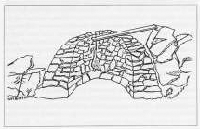
Cross section of a fox trap
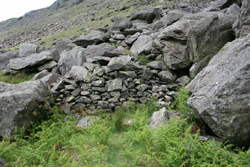
Ruins of a Lakeland fox trap
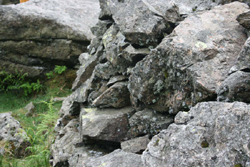
Wall built inward
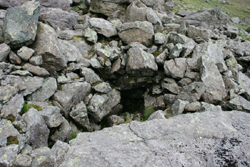
Borran entrance
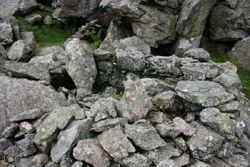
Part view of a trap

Fox trap, Central Baffin Island
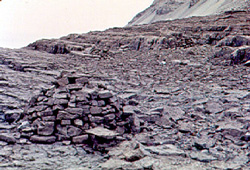
Thule Fox Trap, Ellesmere Island
There
are
eight
"known"
fox
traps
on
the
Lakeland
Fells
-
seven
in
the
Southern
or
Western
Fells
and
one
in
the
Central
Fells.
I
am
unaware
of
any
in
the
Northern
or
Eastern
Fells,
despite
the
large
number
of
borrans
to
be
found
there.
There
may
be
more,
all
the
known
ones
being
in
a
state
of
disrepair
and
difficult
to
spot
amongst
the
boulder
fields,
even
if
you
know
the
location.
Built
in
an
igloo
type
of
construction
of
rough
fell
stone,
they
are
all
nowadays
in
a
state
of
disrepair
(although
at
least
two
have
been
partially
rebuilt
by
well
meaning
enthusiasts
-
see
Fox
Trap
Three).
It
is
evident
however
that
they
all
had
overhanging
walls
which
apparently
were
covered
by
a
roof
of
slabs
with
a
circular
opening
of
about
1.5
metres.
The
floor
was
approx
2
metres
below
but
it
has
been
suggested
that
in
some
a
pit
was
dug
for
added
depth
(the
foxes
they
were
built
for
were
the
"greyhound
type"
now
extinct
but
with
a
body
size
larger
than
the
fox
of
today).
The
date
of
construction
is
unknown,
but
I
suspect
some
are
very
old,
certainly
pre-dating
the
Coniston
Foxhounds
who
formed
in
1825.
However
Fox
Trap
Three
does
not
appear
on
the
OS
6
ins
map
of
the
1860s
and
may
be
a
very
late
example.
They first come to the written record in the 1940s, when the usage was described. It is believed that the trap was baited by some dead goose or duck, etc. hung from a plank, the other end of which was leaning on the fell side or a convenient rock.
The fox walked the plank, so to speak, and when attempting to reach the carcass was tipped into the trap. This story may be believed or taken as some farmer's "leg pull" of the original writer.
Another version (Fox Trap Three) is that some 'old clucker' was put in the trap and the fox climbed a large rock (which is part of the trap), jumped in the hole in the roof and was unable to jump out.
But really no one knows why or how they were used. Broadly speaking despite slight differences in construction they are all the same, i.e. there is no exit point other than the gap in the roof.
This leads one to speculate what happened to the caught fox? Was it left to starve to death? Were terriers put in to 'battle' with it, or was it 'bagged' and sold to a hunt in another district or county? Whatever method, extrication would be a major problem, as I'm pretty sure the roof would not take the weight of a man, who would be unable to reach the floor of the trap anyway, and the surrounding walls are substantially thick.
There is a reference to two brothers in the 1920s who used to bait a trap with a live goose in the evenings and sit and wait with a loaded weapon, but I'm not aware of any references from the 19th century or before.
Foxes have always been a problem to the marginal hill farmer, probably throughout history, and in the main I believe these traps pre-date the foxhound packs and were a tried and trusted method of control.
Postscript
Their method of construction and usage remains a subject for further research, which so far has found details of similar constructions in Central Baffin and Ellesmere Islands, Canada, and north African deserts.
Here's an excerpt from Geological Survey of Canada (no longer available online),describing a fox trap on Central Baffin Island located on an Inuit site populated 200-300 years ago: If you walk about 60 meters southward from the big rock the terrain becomes rocky and by entering a crevasse you come upon the much older part of the entire Nunaqarviminituqait site.... There is one object at this site which gives rise to a little speculation. The object is a tigiriaq, an old traditional fox trap. A tigiriaq looks like a small igloo constructed entirely of stone. The only opening is at its top. You throw in through this opening an old hunk of meat unfit for man or dog. The fox smelling a free meal scampers up the side of the tigiriaq pokes his head into the hole and jumps down to get his reward. Later, try as he may, he cannot get out again and dies. Eventually the hunter/trapper comes by, the fox's skin goes south and his remains go to the ravens and dogs. The construction of the tigiriaq amidst the remains of the old houses suggests that it was constructed after the site was abandoned as a place to live.
Another description of a Thule fox trap on Ellesmere Island, Canada, sourced from the Canadian Museum of Civilisation website (but no longer available online):
Thule people did not confine their building activity to houses; their various stone structures can be found across the Arctic. This fox trap from southern Ellesmere Island is one and a half metres high. The bait was placed inside, and once the fox had jumped in through the entrance at the top of the structure, it was unable to leap back out. The remains of two similar traps can be seen in the background.
There is further research to be found here.
 Website
manager
Website
manager